
If we look back at the history of the automobile as an epoch of time, one must admit that its brief 135-year story represents a mere sliver of our planet’s chronical. Yet when Carl Benz was issued a patent for a ‘vehicle powered by a gas engine’, he certainly could not have fathomed the impact it would have on the human race.
In 1903, Dutch brothers Hendrik and Jacobus Spijker took the concept further by incorporating a four-wheel drive system into their Spyker 60 roadster. Spin the clock forward through the next few decades and there were numerous brands that landed with a big splash, only to sink into oblivion. Those that survived were able to adapt to changing economies, overcome challenges, and reinvent themselves when needed.
This year marks the 80th anniversary of one such brand, whose four-wheel drive offerings have circumnavigated the globe, set Guinness World Records, fought in wars, and even been credited with helping to save the planet from tyranny. This month we are honouring Jeep, the seven-slot brand, by delving into its first eight decades and looking forward as it prepares for the hurdles of the future.
DEEP ROOTS
To understand the deep determination of a brand like Jeep, we need to go back more than a century and join two young entrepreneurs. In 1903, Claud Cox, an engineer with the Standard Wheel Company who had designed their Overland motorcar, launched his own business when his employer pulled the plug on its automobile endeavors.
Struggling for several years, Cox was ultimately destined for bankruptcy. But in an event that would change the future of the world, a visionary bicycle salesman from New York named John North Willys intervened. After witnessing his first horseless carriage and the excitement it generated, Willys knew that the motorcar would eventually render the bicycle obsolete.
Willys struck a deal with Cox – paying $10,000 USD for 51 per cent of the company – and then worked his charismatic magic with creditors, employees and suppliers to keep them in the game. By 1908, the new Willys-Overland company had sold more than 500 automobiles and turned a handsome profit. In short order it had outgrown its building and needed a new home, landing in Toledo, Ohio. It was a decision that would not only change the future of the company but prompted Cox to resign.
By 1916, the brand’s reputation for quality positioned the Overland Model 38 as the second best-selling car in the country. Fast forward through the booming 1920s, tumultuous 1930s, and the passing of John Willys in 1933, and America was gearing up for its inevitable entry into World War II.

THE SEVEN-SLOT GRILLE
With technology running at a breakneck pace, the US Government knew the upcoming war would be like no other. Horse-drawn howitzers were a thing of the past and their ragtag fleet of modified Model Ts would be no match for Germany’s Wehrmacht.
They issued a request to all US auto manufacturers to produce a light reconnaissance vehicle that had four-wheel drive, a fold-down windshield, weighed less than 1300lb, and could carry a crew of three. And the kicker … they wanted fully functioning prototypes in just 50 days. Bantam Motors and Willys-Overland responded, followed by Ford under the urging of the government.
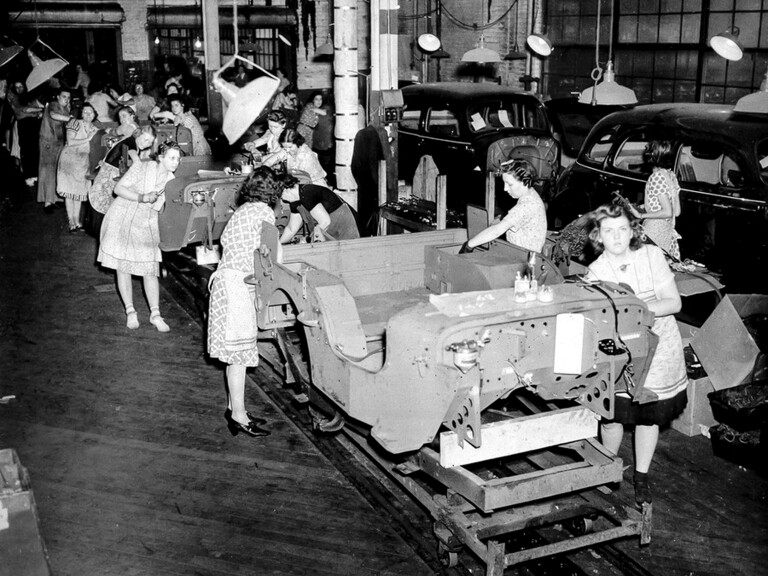
The fruits of their frantic efforts rendered the Bantam BRC, Ford Pygmy, and Willys Quad. Prototypes were evaluated in several rounds of tyre-to-tyre field testing, followed by an order for 1500 more units. When the dust settled, it was the Willys Quad and its powerful GoDevil engine – named so because it would ‘Go like the Devil’ – that received Uncle Sam’s nod of approval. During the war years, Willys produced 363,000 MA and MB models, while Ford, under US license using Willys specifications, manufactured more than 280,000 of their GPWs.
There have been many campfire debates on where the Jeep moniker came from. Some claim it was slang for General-Purpose vehicle (GP), while others argue it sprung from a gravity-defying character in the 1930s Popeye cartoon, Eugene the Jeep. Whatever the origin, by the end of WWII the world had embraced this nickname and Jeep quickly became part of the international lexicon.

PEACE TIME AND CIVILIAN JEEPS
As peace settled over the planet, the venerable Jeep, which had been deployed on six continents, had become known as the vehicle that helped win the war. Surplus units were sold at auction to farmers, outdoorsmen and adventurers, and Uncle Sam authorised Willys to produce the MB for the consumer markets. It would be deemed the CJ-2A (civilian Jeep) and its agile suspension, open-air design and proven durability, made an easy transition from the front lines to field and stream. Looking back, the CJ-2A and its seven-slot grille would provide inspiration for dozens of Jeep models for the next 70 years.
Extending its reach in 1947, licensing was also granted to several international automakers, some of which continue to produce vintage-style Willys to this day. Its simple, utilitarian design and dependability also prompted several manufacturers to produce nearly identical knock-offs. But as they say, imitation is the finest form of flattery.
Spinning the clock forward to the late ’40s and 1950s when the brand was eventually purchased by Kaiser Automobiles, Jeep continued on its self-directed path. Focusing on the needs of the rugged individualist, it would develop vehicles for family camping, hard-working farm and fire trucks, and sporty beach cruisers.
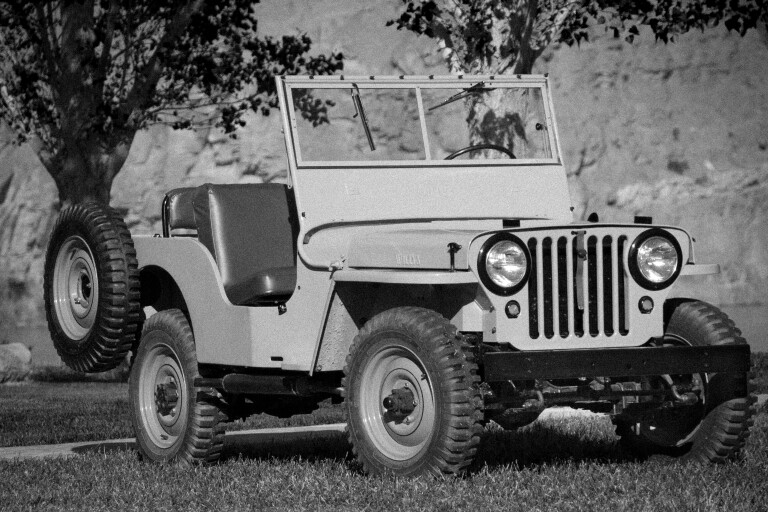
THE SEVEN SLOT LINEUP
Although a detailed presentation of every Jeep model could consume several books, a celebration of Jeep’s 80th anniversary would not be complete without highlighting the vehicles that made it what it is today. Here we go, 1945 and the end of WWII to the turn of the 21st century.
1945 JEEP CJ-2A
After the end of WWII, the success of the MB prompted Willys to focus on Jeeps and drop its car line. The CJ-2A was born (aka Universal), featuring larger headlights, softer springs, a relocated spare tire, and multiple color options. By its phase-out in 1949 in lieu of the CJ-3A and 3B, more than 200,000 2As rolled out of the Toledo, Ohio, manufacturing plant.
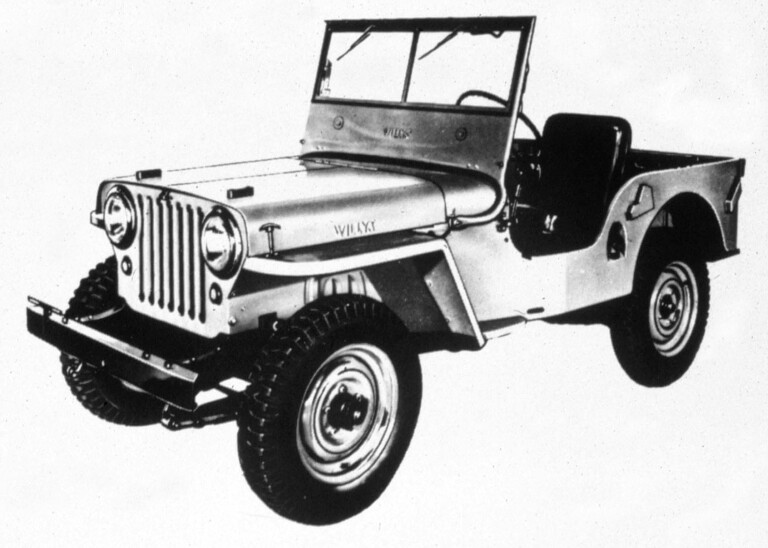
1946 WILLYS WAGON
One can argue that the Willys Wagon, designed by the legendary Brook Stevens, was the first sports utility vehicle. It had two rows of seating, room for four, and cargo in the back. During the next 18 years (it was also manufactured in Argentina and Brazil through 1977) it underwent various design changes, engines and drivetrain systems, including 4WD in 1949. The Willys wagon became an American icon of backcountry family adventures.
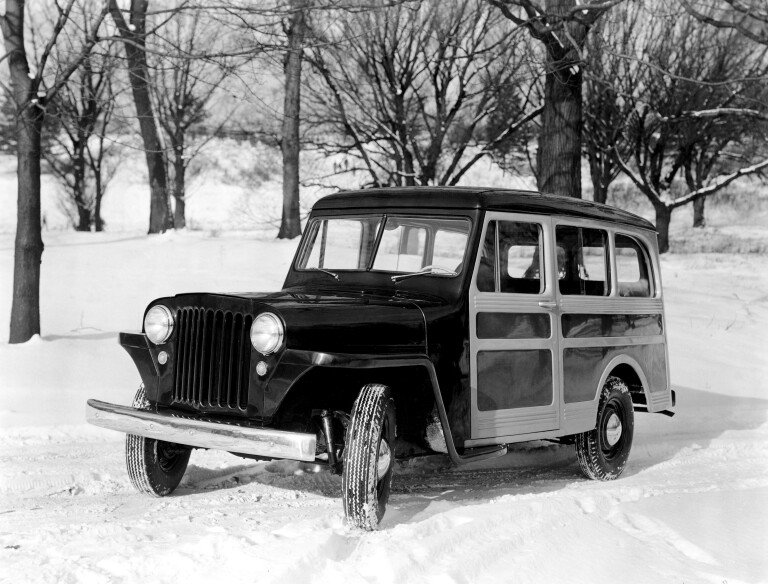
1947 WILLYS PICKUP
With pickups becoming ever popular, Willys introduced the Jeep Truck, which would enjoy an 18-year tenure before being retired in 1965.
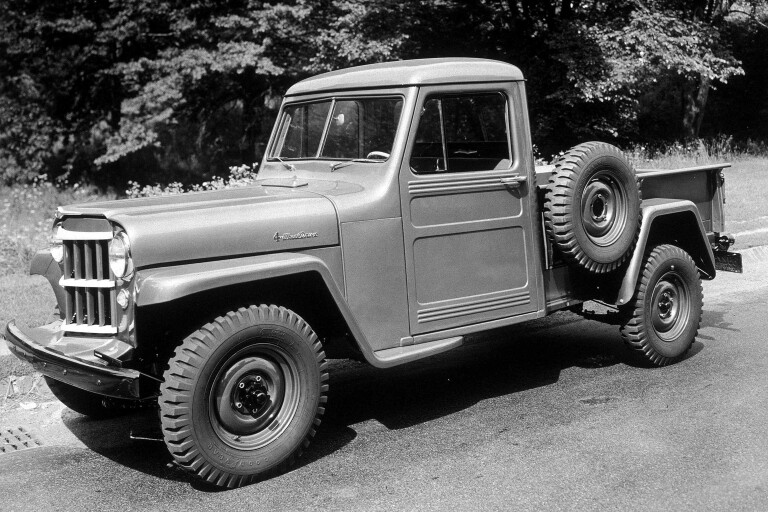
1948 JEEPSTER
Another Brook Stevens design, the Jeepster was a bit more luxurious, sportier, and car-like than its brethren, and targeted the beach cruiser and country club crowd. While its bones were borrowed from the Willys Wagon, it featured soft touches such as whitewall tires, sun visors, wind wings, and a convertible top.

1955 CJ-5
After Kaiser purchased Willys-Overland in 1953, they rebranded the Korean War era M38-A1 for the civilian market. The beloved CJ-5 became the longest running Jeep to date, spanning 29 years, numerous wars, 4-bangers, 6-bangers and V8s, and chassis upgrades. By the end of production, more than 600,000 units had been delivered worldwide.
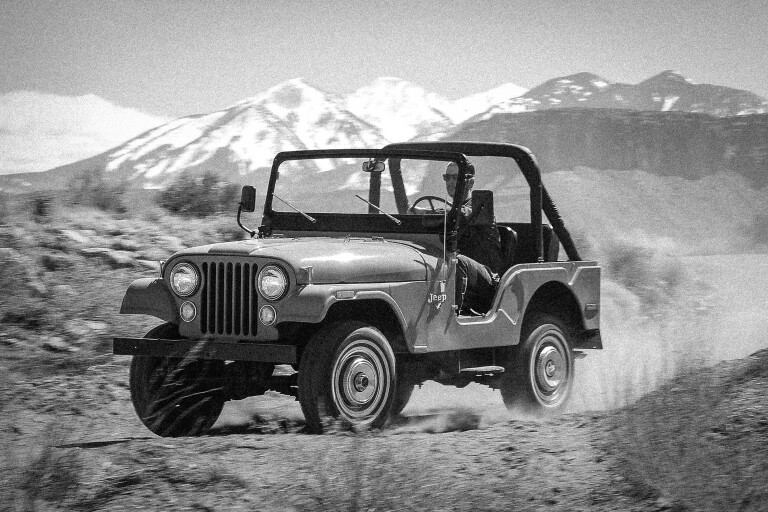
1963 GLADIATOR PICKUP
One of the most coveted Jeeps (if you can find one), the full-size J Series pickups became the workhorses of the farm, road and trail. Their aggressive forward-raked front clip may not have been aerodynamic, but it was pretty dang cool. It was also beefed up to a 1.25-ton (1.13-tonne) rating for military use and designated the M715.
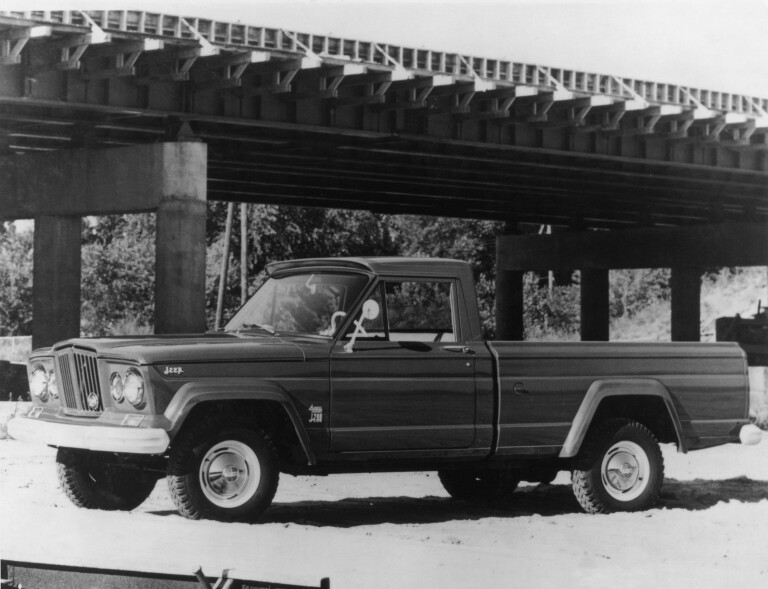
1963 WAGONEER
If the Willys Wagon was the first SUV, the Wagoneer took things to the next level in luxury. Sparing with the CJ-5, it too was produced for 29 years and had little competition. Based on the J series pickup chassis, it was available in two or four doors, accent lighting, woodgrain panels, an automatic transmission, and engines ranging from the Tornado 3.8-litre six-cylinder to a fire-breathing 401 cubic-inch V8. It would also be the inspiration for its smaller sibling the Cherokee XJ (1983-2001) and modern Grand Cherokee.

1976 CJ-7
As highway speeds increased and vehicles became bigger, the world wanted a more stable and larger Jeep. AMC followed suit by stretching the CJ-5 10 inches and rebranding it as the CJ-7. There were subtle changes to the chassis and powertrains, but it proudly carried the seven-slot flag until its retirement in 1986 as the last of the CJ line.
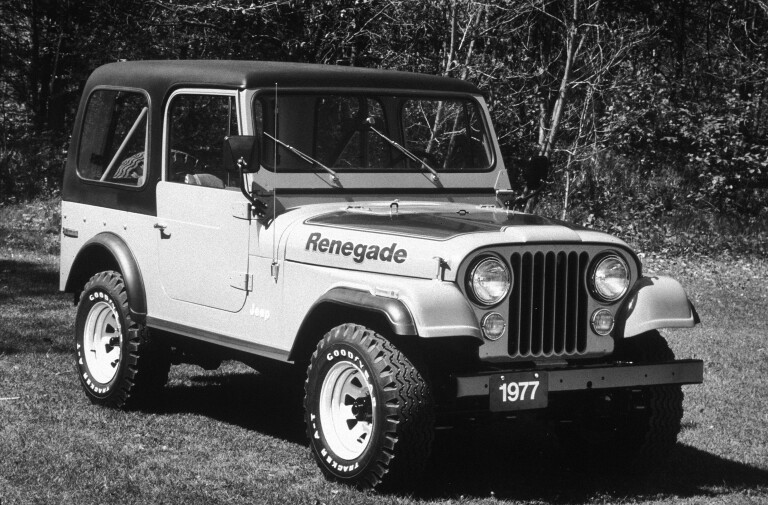
1986 WRANGLER
The Wrangler took over where the CJ left off, and has been with us in various forms for 35 years. Though variants have included the YJ, TJ, JK and the new JL, the most significant upgrade for the off-road minded was the introduction of the coil-sprung TJ in 1996, the Rubicon in 2003, and four-door in 2007.
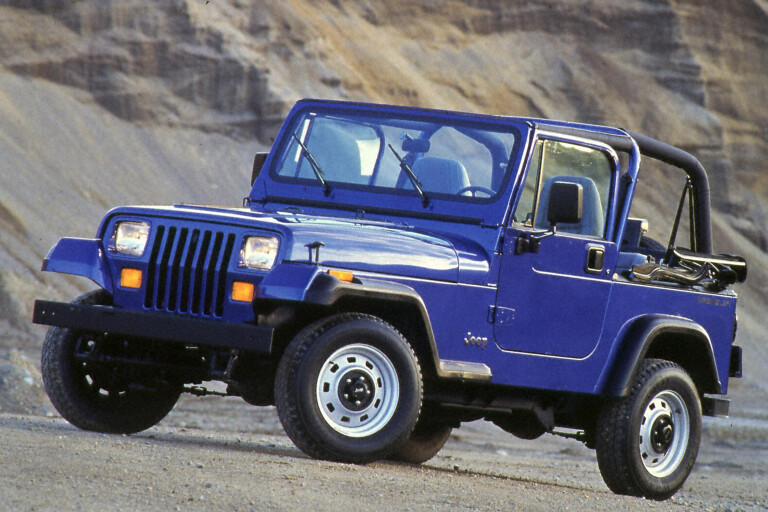
ODDBALLS AND GOING POSTAL
As with any brand, Jeep has come out with a few humdingers. There were many from offshore licensees, but we’ll stick to US blunders.
The Forward Control (FC) was another creation of the legendary Brook Stevens, but its cab-over design was unconventional for the day and received with mixed reviews. And lest we forget the FJ Fleetvan. Produced from 1961 to 1976, this pug-nosed van came in a variety of flavours and made its mark as a right-hand drive (RHD) postal delivery vehicle.
Jeep also went postal with the RHD DJ-5A, or dispatch jeep. Based on the CJ-5, it had a sliding side door and Powerglide automatic transmission and along with the Fleetvan, was the only RHD Jeep offered in North America.

SEVEN SLOTS DOWN UNDER
With thousands of surplus Willys MBs and Ford GPWs available after WWII, demand did not merit the importing or manufacturing of Jeeps in Australia until the late 1950s. When the supply of military Jeeps ran dry, they began to arrive in crates and were assembled at the MS Brooking facility in Perth, Western Australia, and later by Willys Motors Australia in Brisbane, Queensland.
“Jeep vehicles doing Australia’s hardest work” was the motto, and the line expanded to include Willys wagon, pickups, Wagoneers, Forward Controls, and even a solitary Fleetvan. At the time, many parts such as electrical systems, various body panels, engines and ute trays were sourced locally or redesigned for the needs of folks in the outback. This included the Overlander, which was produced as a ute and wagon.

With AMC’s purchase of Jeep in 1970 and demand waning, it appeared that the seven-slot grille had seen its last day Down Under. But in the early ’80s AMC was back at the plate, establishing Jeep Australia to assemble the CJ-8, Overlander and CJ-10. All bets were off again in 1984, and on again in 1990. Exchange rates and other factors have contributed to this bumpy ride and while Jeep has not had the presence of other brands, it continues to have a strong and loyal following.
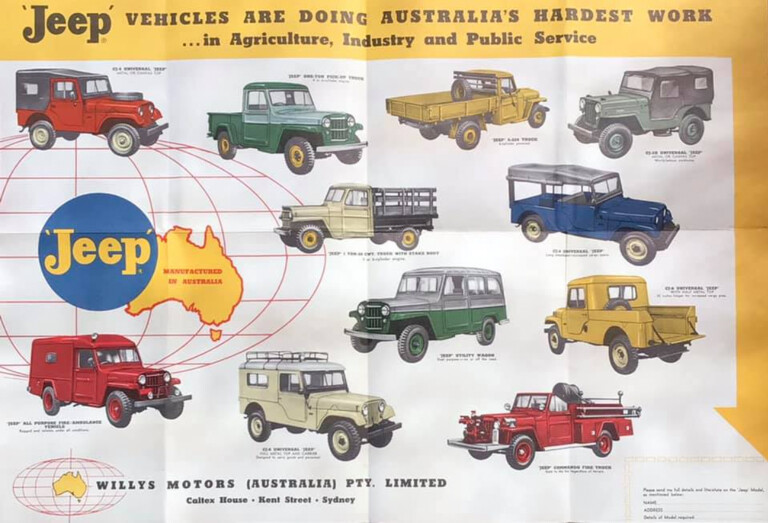
TUMULTUOUS TIMES
The Willys brand was eventually acquired by a long succession of parent companies ranging from Kaiser to Fiat. Each took their turn at amalgamating the brand with their own, but Jeep was different than anything they had experienced. It had true global identity, a devoted following and bulldog-stubborn management. Through recessions, oil embargos, market crashes, global economic pressures and wars, the brand continued to forge forward with relative autonomy.
Interestingly, if we look back to 1920, Walter P Chrysler had been commissioned by a group of bankers to help restructure Willys, which was heading for bankruptcy again. Although he left after a botched coup attempt to edge out founder John Willys, the company he later formed, the Chrysler Corporation, would eventually purchase American Motors and the Jeep brand from Renault.

JEEP EXPEDITIONS, EVENTS AND PEOPLE
While it is commonly accepted that the Willys helped win the war, Jeeps have undertaken some of the most incredible, inspiring and unlikely expeditions on record. They have traversed uncharted deserts of Africa, passed through countries many have never heard of, driven through the world’s densest jungles and even crossed oceans. We begin this journey of exploration with the legendary Long Range Desert Group.

1943 Long Range Desert Group: As a product of the WWII efforts, the first Jeeps, or Ford GPWs, were deployed in Libya to battle the Axis Alliance. Laden with machine guns, heaps of ammunition and fuel, they sneaked in behind enemy lines for hit-and-run and recce missions.
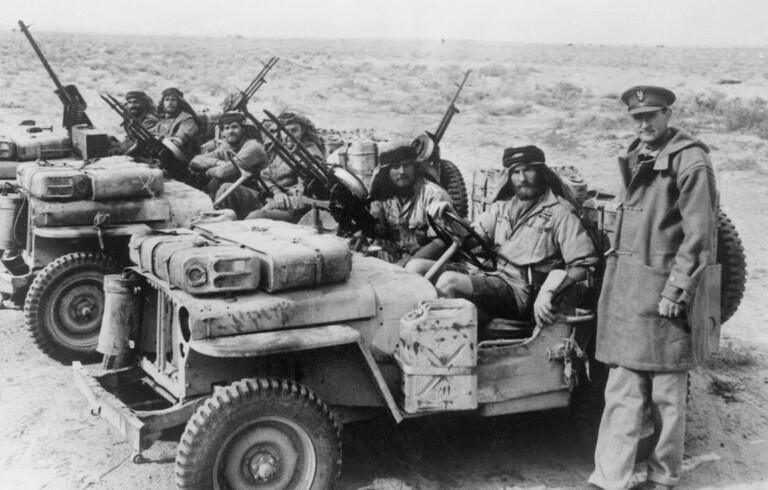
1948 Half Safe: One of the most impressive early Jeep expeditions was undertaken by Australian Ben Carlin. Piloting a 1942 Ford GPA amphibian, Carlin and his wife Elenore set off from Halifax, Canada, on a circumnavigation of the globe. It took Carlin three co-drivers and 10 years to complete a journey of 63,000 miles on land and 17,000 miles by sea.
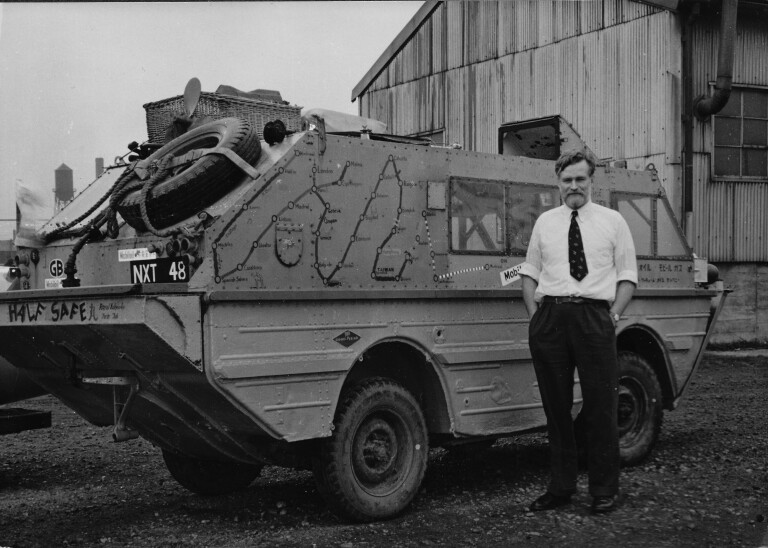
1953 Jeepers Jamboree: Mark A Smith and a group of friends in Georgetown, California, organised a Jeep trip on the Rubicon Trail to help boost the town’s sagging economy. Little did they know their fledgling event would be nicknamed ‘The Granddaddy of Jeep Trips’ and their hometown trail would become known the world over.
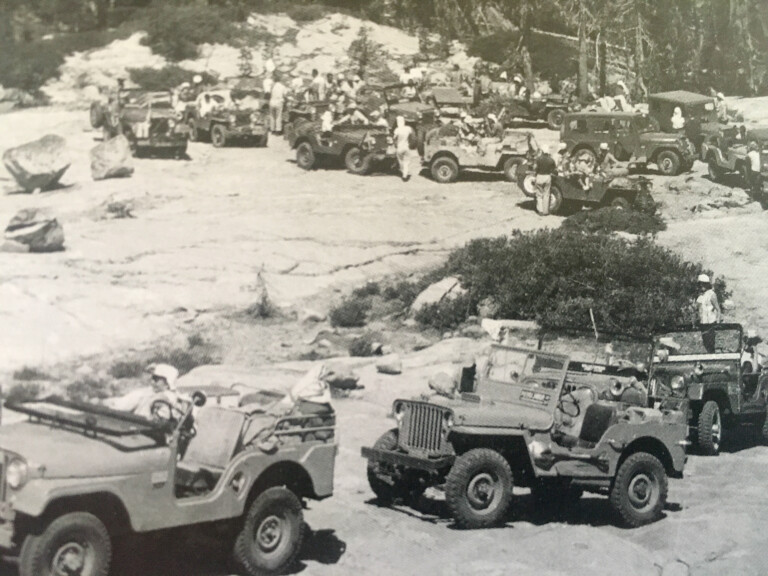
1954-55: Helen and Frank Schreider traversed the Americas from Alaska to the tip of South America in an amphibious Ford GPA named La Tortuga. They would go on to undertake numerous expeditions around the world for the National Geographic Society; usually at the helm of La Tortuga.

1958 Singapore to England Overland: Roy Follows and Noel Dudgeon spent a year piloting their British surplus Willys, utilised during the WWII efforts in Burma, from Singapore to London.
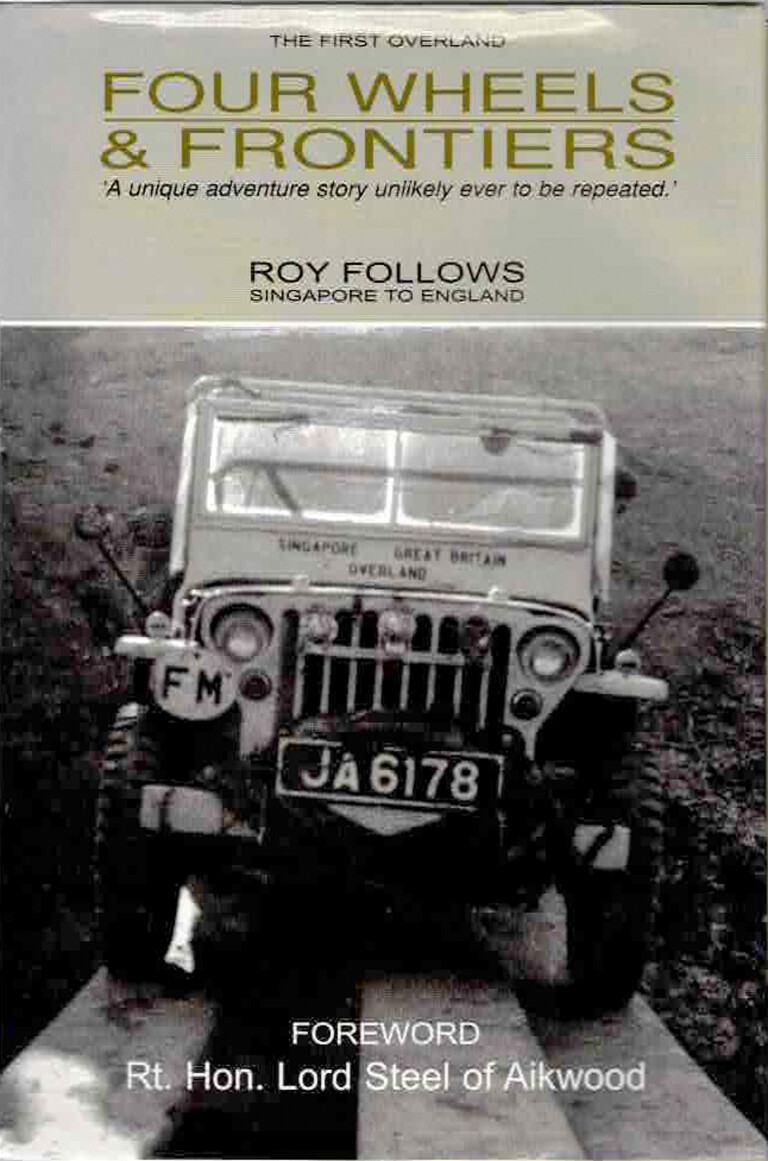
1969 East West Australia: Ian McDonald and his small team made the first east-to-west crossing of the Simpson Desert as part of a 6000-mile expedition from Cape Byron to Steep Point.

1978 Expedicion de las Americas: With five stock CJ-7s, Mark A Smith and a small team made the first unsupported crossing of the infamous Darien Gap between Panama and Colombia during their 21,000-mile trek from the tip of North America to the tip of South America.

1982 Jeep Jamboree USA: Mark Smith’s vision to create an international Jeep culture prompted him to launch Jeep Jamboree USA. In the coming decades, he expanded the event roster to include dozens of Jamboree events around the world.

1984-89 A World Odyssey: Loren and Patty Upton set a Guinness World Record for the longest four-wheel drive journey by automobile in a 1966 CJ-5 called the Sand Ship Discovery. The journey included the first solo all-land crossing of the Darien Gap.
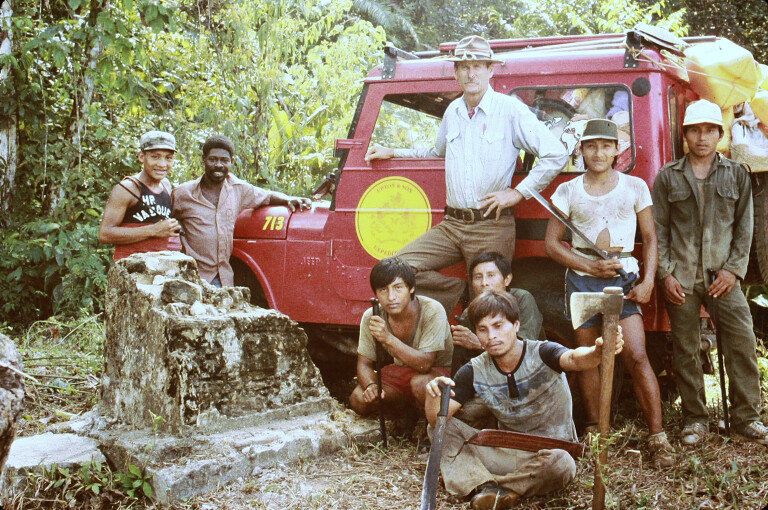
In 2019, author Chris Collard and publisher Ben Davidson successfully recreated East West Australia in celebration of its 50th anniversary, which included 1969 East West members Ian McDonald and John Eggleston.
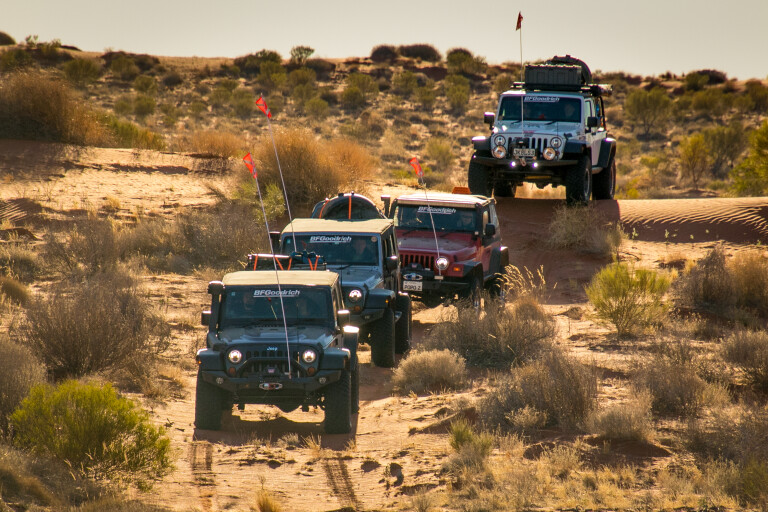
SURVIVAL OF THE FITTEST
Our 80-year timeline puts Jeep under the umbrella of Kaiser, AMC, Renault, Chrysler, Daimler-Benz, Fiat, and now Stellantis. There have been some rough spells, but the brand prevailed in the presence of reorganisations, acquisitions, down-sizing, up-scaling, and global market meltdowns. Like the soldiers it has carried into battle the world over, it is a survivor, beholden only to its ethos of producing rough-and-ready machines and determination to prevail.
While Jeep’s current offerings range from new uber-opulent Grand Wagoneer to the compact Renegade, we need to give a shout out to the Wrangler Rubicon, Gladiator Mojave and new Grand Cherokee L. In each case, these models have defined the upper boundaries of supreme capability, high-speed desert performance and luxurious appointments. The auto industry is currently in a state of flux, and will be in the foreseeable future. But how does that look for the brand that created the off-road genre?

RETRO-MODERN CONCEPTS
For more than a decade, the design team at Jeep has confirmed its dedication to the brand’s DNA via their annual fleet of Moab concepts. Each represents a model from a different era, melded together with modern powertrains and creative queues from their predecessors. Behold the Five-Quarter 715, Sarge J8, Mighty FC and Jeepster Beach Commando.
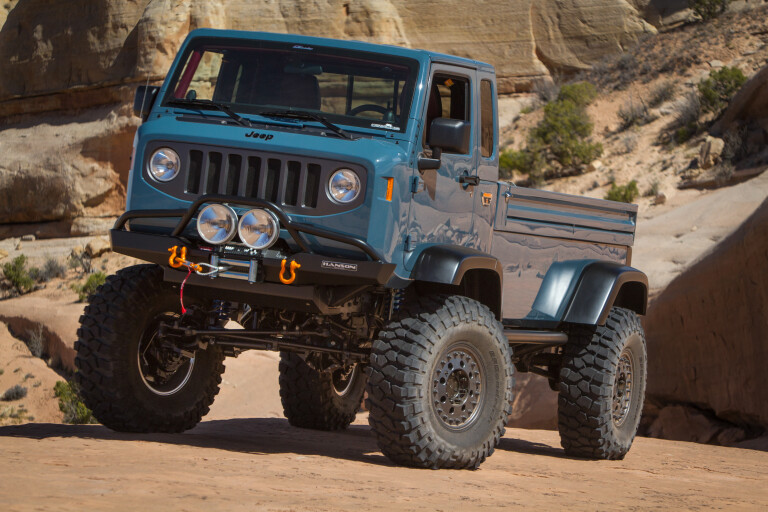
ELECTRIFYING FUTURE
We recently sat in on a meeting with Jeep’s top brass to hear what’s in store for the coming decades. Based on global energy and environmental concerns, it was no surprise when they confirmed the future will be electrifying … as in hybrids, full EVs and artificial intelligence. The 49-mpg (20.8km/L) Wrangler 4xe hybrid is rolling out as we speak, and the plan is to have zero-emission options for all product lines by 2025. Jeep is also dedicated to having 70 per cent of its sales worldwide be electrified in some way in the next four years.
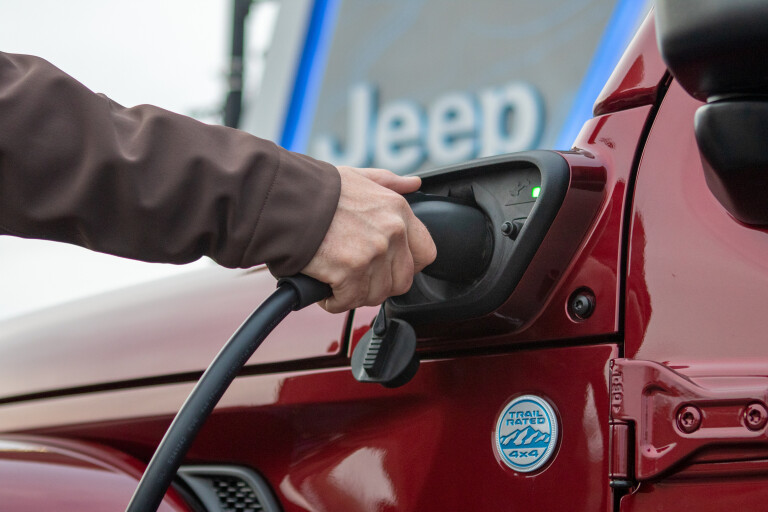
Other ambitious goals include autonomous off-road driving, biometric owner recognition, vehicle-to-vehicle charging, drone pairing (for the ultimate selfies), and dynamic tyre inflation (CTIS). This news of rapid developments in high-tech electrification begged the question … can they do all of this while maintaining its legendary capability? With an excitement in their eyes, they assured us that the future looks bright. The seven-slot brand will continue to be competitive and compliant, yet dedicated to maintaining the Jeep’s ethos as a premium off-road offering. Ambitious, we think so.
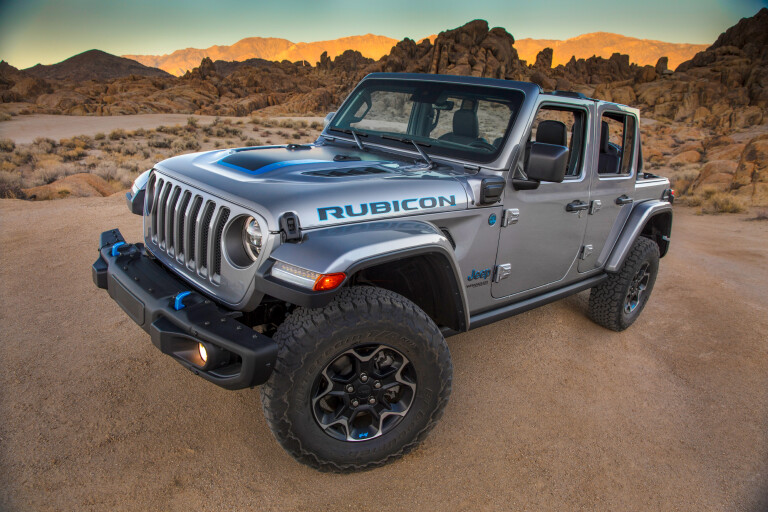
Jeep Taglines Through the Years
1945: Like a Bat out of Hell
1959: Anywhere, Anytime, Any Job
1963: Great Fun in a New Fashion
1965: The Unstoppable Jeep Gladiator
1970: Classic Beauty in a 4-Wheel Drive
1971: The One That Goes Where Others Can’t
1974: Built for the Fun of Real Adventure
1977: We Wrote the Book on 4-Wheel Drive
1983: Why Drive a Car When You Can Drive a Jeep
1990: There’s Only One Jeep
2004: Trail Rated

COMMENTS